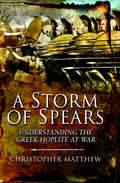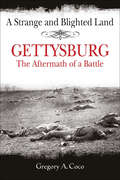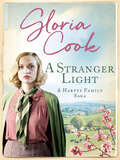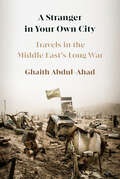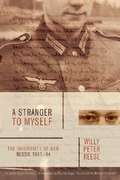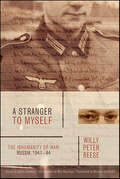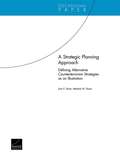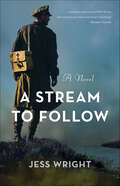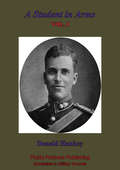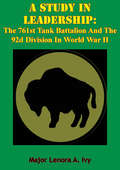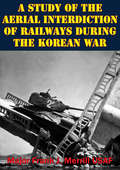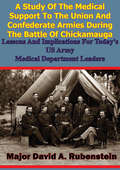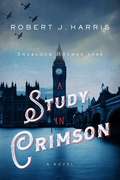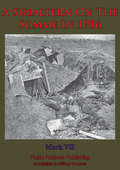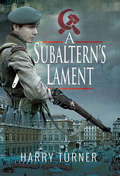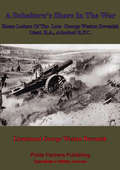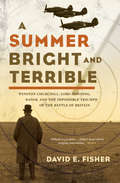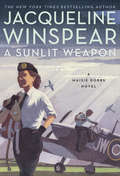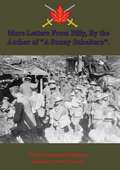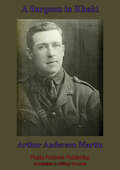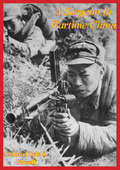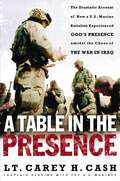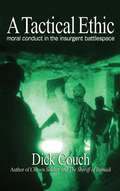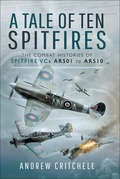- Table View
- List View
A Storm of Spears: Understanding the Greek Hoplite at War
by Christopher MatthewA “practical and thought provoking” study of the ancient military tactic known as the phalanx—the classic battle formation used in historic Greek warfare (The Historian). In ancient Greece, warfare was a fact of life, with every city brandishing its own fighting force. And the backbone of these classical Greek armies was the phalanx of heavily armored spearmen, or hoplites. These were the soldiers that defied the might of Persia at Marathon, Thermopylae and Plataea and—more often than not—fought each other in countless battles between the Greek city-states. For centuries they were the dominant soldiers of the classical world, in great demand as mercenaries throughout the Mediterranean and Middle East. Yet, despite the battle descriptions left behind and copious evidence in Greek art and archaeology, there are still many aspects of hoplite warfare that are little understood or the subject of fierce academic debate. Christopher Matthew’s groundbreaking work combines rigorous analysis with the new disciplines of reconstructive archaeology, reenactment, and ballistic science. He examines the equipment, tactics, and capabilities of the individual hoplites, as well as how they used juggernaut masses of men and their long spears to such devastating effect. This is an innovative reassessment of one of the most important early advancements in military tactics, and “indispensable reading for anyone interested in ancient warfare (The New York Military Affairs Symposium).
A Strange and Blighted Land: Gettysburg: The Aftermath of a Battle
by Gregory Coco“An exhaustive compilation of first-hand accounts of the Gettysburg battlefield in the days, weeks, and months following the fight . . . heartbreaking.” —Austin Civil War Round TableGettysburg (July 1-3, 1863) was the largest battle fought on the American continent. Remarkably few who study it contemplate what came after the armies marched away. Who would care for the tens of thousands of wounded? What happened to the thousands of dead men, horses, and tons of detritus scattered in every direction? How did the civilians cope with their radically changed lives? Gregory Coco’s A Strange and Blighted Land offers a comprehensive account of these and other issues.Arranged in a series of topical chapters, A Strange and Blighted Land begins with a tour of the battlefield, mostly through eyewitness accounts, of the death and destruction littering the sprawling landscape. Once the size and scope are exposed to readers, Coco moves on to discuss the dead of Gettysburg, North and South, how their remains were handled, and how and why the Gettysburg National Cemetery was established. The author also discusses at length how the wounded and prisoners were handled and the fate of the thousands of stragglers and deserters left behind once the armies left before concluding with the preservation efforts that culminated in the establishment of the Gettysburg National Military Park in 1895.Coco’s prose is gripping, personal, and brutally honest. There is no mistaking where he comes down on the issue: There was nothing pretty or glorious or romantic about a battle—especially once the fighting ended.
A Strange and Blighted Land: The Aftermath of a Battle
by Gregory A. CocoThe more dismal side of the Gettysburg campaign is covered: burials of Union and Confederate corpses, removal of the 3,000 horses killed, care of the wounded, descriptions of field hospitals, disposition of POWs, cleanup of the battle ground, collection of weapons, early relic hunters, battlefield guides, and a tour of the grim and bloody fields as described by a host of early visitors.
A Stranger Light (Harvey Family Sagas)
by Gloria CookA family's struggle for love and hope in the aftermath of war In the aftermath of the Second World War, Faye Harvey struggles against the stigma of being a single mother. Faye is drawn to former POW Mark Fuller, but then the father of her son, a Scottish laird, offers marriage now he is a widower. Faye is torn. Meanwhile Tristan falls for the new housekeeper Susan Dowling, but their age difference and her distrust seem to make love impossible. And over at Ford Farm, Faye's cousin Lottie Harmon, begins to fear she may not want a new life with her GI husband after all… Fans of Rosie Clarke and Nadine Dorries will love the fifth compelling Harvey Family Saga.
A Stranger in Your Own City: Travels in the Middle East's Long War
by Ghaith Abdul-AhadAn award-winning journalist&’s powerful portrait of his native Baghdad, the people of Iraq, and twenty years of war.&“An essential insider account of the unravelling of Iraq…Driven by his intimate knowledge and deep personal stakes, Abdul-Ahad…offers an overdue reckoning with a broken history.&”—Declan Walsh, author of The Nine Lives of Pakistan: Dispatches from a Precarious State&“A vital archive of a time and place in history…Impossible to put down.&”—Omar El Akkad, author of What Strange Paradise The history of reportage has often depended on outsiders—Ryszard Kapuściński witnessing the fall of the shah in Iran, Frances FitzGerald observing the aftermath of the American war in Vietnam. What would happen if a native son was so estranged from his city by war that he could, in essence, view it as an outsider? What kind of portrait of a war-wracked place and people might he present?A Stranger in Your Own City is award-winning writer Ghaith Abdul-Ahad&’s vivid, shattering response. This is not a book about Iraq&’s history or an inventory of the many Middle Eastern wars that have consumed the nation over the past several decades. This is the tale of a people who once lived under the rule of a megalomaniacal leader who shaped the state in his own image; a people who watched a foreign army invade, topple that leader, demolish the state, and then invent a new country; who experienced the horror of having their home fragmented into a hundred different cities.When the &“Shock and Awe&” campaign began in March 2003, Abdul-Ahad was an architect. Within months he would become a translator, then a fixer, then a reporter for The Guardian and elsewhere, chronicling the unbuilding of his centuries-old cosmopolitan city. Beginning at that moment and spanning twenty years, Abdul-Ahad&’s book decenters the West and in its place focuses on everyday people, soldiers, mercenaries, citizens blown sideways through life by the war, and the proliferation of sectarian battles that continue to this day. Here is their Iraq, seen from the inside: the human cost of violence, the shifting allegiances, the generational change.A Stranger in Your Own City is a rare work of beauty and tragedy whose power and relevance lie in its attempt to return the land to the people to whom it belongs.
A Stranger to Myself: The Inhumanity of War: Russia, 1941-1944
by Willy Peter ReeseWilly Peter Reese was only twenty years old when he found himself marching through Russia with orders to take no prisoners. Three years later he was dead. Bearing witness to--and participating in--the atrocities of war, Reese recorded his reflections in his diary, leaving behind an intelligent, touching, and illuminating perspective on life on the eastern front.
A Stranger to Myself: The Inhumanity of War: Russia, 1941–44
by Willy Peter ReeseA Stranger to Myself: The Inhumanity of War, Russia 1941-44 is the haunting memoir of a young German soldier on the Russian front during World War II. Willy Peter Reese was only twenty years old when he found himself marching through Russia with orders to take no prisoners. Three years later he was dead. Bearing witness to--and participating in--the atrocities of war, Reese recorded his reflections in his diary, leaving behind an intelligent, touching, and illuminating perspective on life on the eastern front. He documented the carnage perpetrated by both sides, the destruction which was exacerbated by the young soldiers' hunger, frostbite, exhaustion, and their daily struggle to survive. And he wrestled with his own sins, with the realization that what he and his fellow soldiers had done to civilians and enemies alike was unforgivable, with his growing awareness of the Nazi policies toward Jews, and with his deep disillusionment with himself and his fellow men.An international sensation, A Stranger to Myself is an unforgettable account of men at war.
A Strategic Planning Approach
by Lynn E. Davis Melanie W. SissonWhile the United States government has historically undertaken strategic reviews and produced numerous strategy documents, these have provided only very general directions for U.S. policymakers. This paper defines an approach to strategic planning and illustrates its application using the example of the critical national security topic of counterterrorism.
A Stream to Follow: A Novel
by Jess WrightWhen WWII ends, Bruce Duncan, a battlefront surgeon, returns home to a small town in Pennsylvania with plans of opening a general practice, fly fishing in his spare time, and forgetting the past. But the ravages of his war aren’t over. Haunted by images of soldiers he tried to save, his own near-death experiences, and the love he lost, Bruce has little respite before new battles grip him. His brother, a decorated fighter pilot, is sinking fast and rebels against Bruce’s attempts to help him. A former friend begins waging a vicious campaign to stop Bruce from uncovering the dangers that could shutter a local industry. And amid all this turmoil, he must decide between the slim prospect of reuniting with his former love—an Englishwoman who chose her family over him—and an ill-fated attraction to a trail-blazing woman doctor.A riveting narrative that moves from post-WWII America to battle-sieged England to the killing fields of Alsace, A Stream to Follow plunges deep into the crucible of trauma and gives fresh vision for paths to redemption—ultimately weaving an uplifting tale of valor, resilience, and enduring love.
A Student In Arms Vol. I (A Student in Arms #1)
by John St Loe Strachey Donald StracheyAfter Donald Hankey returned home from a posting with the Royal Garrison Artillery in Mauritius, following a serious bout of illness, it seemed as though he was destined for a career in the Church. Finding the clergy schools to be too stultifying, he set to work in missionary positions in the most impoverished communities in the east of London. As the First World War began to take its ominous toll of men, the first of Kitchener's recruiting calls was heard throughout the Empire; Hankey eschewed returning to the army as an officer and decided to enlist as a "gentleman ranker". However, his previous military experience marked him out and he was promoted, soon after which he would embark on his first tour of duty on the Western Front. Wounded at Ypres in a daylight infantry charge across no man's land, and having been published previously, he began to send articles to the Spectator from the front. He finally met his end on 12th October 1916 during the later phases of the battle of the Somme.John St Loe Strachey, the then editor of The Spectator, put together the articles along with unpublished papers to produce the two volume "A Student In Arms" as a tribute and memorial to Donald Hankey. Initially published in America to ensure that it passed censorship, it became a bestseller on both sides of the Atlantic in short order running to many editions (this text is taken from the 16th edition). The two volumes are often reflective in tone, between the jingoistic volumes produced at the beginning of the war and the despairing disillusioned books produced afterward. It is also clear the affinity that Hankey felt for the common soldier, and made no secret of the fact that he believed that the ranker who had so little to gain from sacrificing himself for the society at home put many of his supposed betters to shame.
A Study In Leadership: The 761st Tank Battalion And The 92d Division In World War II
by Major Lenora A. IvyThis thesis evaluates leadership in the 761st Tank Battalion and the 92d Division, two black units during World War II. Leaders in each unit were evaluated on their ability to use the following leadership model: technical skills (job experience, technical competence, and the ability to correlate facts into meaningful information); conceptual skills (vision and the ability to task organize to accomplish the mission); and interpersonal skills (job related standards and the ability to foster mutual trust and respect) to influence combat effectiveness.The analysis showed that the leaders in the 761st Tank Battalion demonstrated skills in the leadership model effectively and especially were successful in demonstrating interpersonal skills. Its successful combat record supports that its leaders were effective. On the other hand, the leaders in the 92d Division failed to properly demonstrate the skills of the leadership model. The lack of interpersonal skills used by leaders in the division (developing trust and mutual respect) was the major cause of the unit's combat failures.This study showed that despite negative beliefs about Negro soldiers there were some leaders who effectively applied interpersonal leadership skills in the interest of mission accomplishment.
A Study Of The Aerial Interdiction of Railways During The Korean War
by Major Frank J. Merrill USAFThis study undertakes to examine the aerial interdiction activities conducted against the enemy railway system by United Nations' forces during the Korean War, June 1950-July 1953. It has three major goals: (1) to compile a concise history of these interdiction activities; (2) to evaluate the effectiveness of these efforts as it might relate to the conduct of the total war effort; and (3) to make recommendations pertaining to the future conduct of aerial interdiction.
A Study Of The Medical Support To The Union And Confederate Armies During The Battle Of Chickamauga: Lessons And Implications For Today’s US Army Medical Department Leaders
by Major David A. RubensteinThe Union's Campaign for Chattanooga, Tennessee, and its resulting Battle of Chickamauga, is a valuable study of marked contrasts. On the one hand, brilliant strategic planning and operational maneuver, in concert with skillful deception, allowed the Union's Army of the Cumberland to advance virtually unchallenged into the vital Southern city of Chattanooga on 9 September 1863. Following this drive into the gateway of Georgia and the Confederacy, however, was the Union defeat on the tactical battlefield just twelve miles to the southwest. Supporting each army was a medical support system grounded on the experiences and lessons of previous campaigns and battles. Both armies had medical leaders familiar with the medical organization, its recent accomplishments, and its capabilities. How these leaders applied the medical support doctrine of the era, within the scope of their duties, affected the lives of thousands of soldiers wounded on the Chickamauga battlefield.The objective of this study is to examine the medical structures of both combatants, describe medical actions during the Chickamauga Campaign, from August to October 1863, and evaluate the effectiveness of each. As a result of this analysis appropriate implications are offered to the leadership of the Health Service Support system in the United States Army of 1990. Among the various implications discussed are the need for Health Service Support planning, tactical competence, staff cooperation, unity of command, and understanding of unique casualty care issues. The intended beneficiary of this historical analysis, and its suggested requirement of complete command support and dedicated medical training, is the very essence of an army: the soldier.
A Study in Crimson: Sherlock Holmes 1942
by Robert J. HarrisBringing Sherlock Holmes from the Victorian Era into the dark days of World War II, this imaginative new thriller confronts the world&’s greatest detective with a killer emulating the murders of Jack the Ripper.London, 1942. A killer going by the name of &“Crimson Jack&” is stalking the wartime streets of London, murdering women on the exact dates of the infamous Jack the Ripper killings of 1888. Has the Ripper somehow returned from the grave? Is the self-styled Crimson Jack a descendant of the original Jack—or merely a madman obsessed with those notorious killings? In desperation Scotland Yard turn to Sherlock Holmes, the world's greatest detective. Surely he is the one man who can sift fact from legend to track down Crimson Jack before he completes his tally of death. As Holmes and the faithful Watson tread the blacked out streets of London, death waits just around the corner. Inspired by the classic film series from Universal Pictures starring Basil Rathbone and Nigel Bruce, which took Sherlock Holmes to the 1940s, this is a brand-new adventure from a talented author who brilliantly evokes one of mystery fiction&’s most popular characters.
A Subaltern On The Somme In 1916
by Mark Vii Pseud."The author of this memoir arrived on the Western Front to join 10th Bn. West Yorks in July 1916, shortly after the opening day of the Battle of the Somme in which his battalion had suffered the highest casualties of any battalion on that day - 710 of whom 306 were killed. His war ended in January 1917 when he was concussed by a shell exploding on the parapet in front of him.Regarded as one of the classics the book gives a vivid description of life in the trenches - the routine, the boredom , the mud and the horror. His war ended in January 1917 when he was concussed by a shell exploding on the parapet in front of him. Well recommended."-N&M Print Version
A Subaltern's Lament
by Harry TurnerVienna 1954, nine years after the end of World War II and the victorious allies occupy the whole of Austria.Newly commissioned national serviceman and Fulham boy, Rory Trenchard, joins his regiment, The Hambleshires, in Vienna at the very height of the Cold War. At nineteen he finds himself not only learning the tough art of soldiering alongside his platoon of Battle hardened Korean War veterans but is also exposed to the political machinations that exist between Britain and her Allies.Vienna in 1954 is a dangerous place and in addition to honing his skills as a warrior he is trusted to act as a go-between when a senior KGB officer plans to defect to the west. He also falls in and out of love with an American girl and faces the choice of either just completing two years national service, or becoming a regular officer.
A Subaltern’s Share In The War: Home Letters Of The Late George Weston Devenish Lieut. R.A., Attached R.F.C.
by Lieutenant George Weston DevenishLieutenant Devenish celebrated his twenty-first birthday, his last in peace-time, on the 25th of July 1914; he was by this point in his short life a soldier by profession and by choice. Having left Charterhouse with a taste for military ways after training in the O.T.C., he decided that his chosen profession should be spent in the Royal Artillery and entered into further training at Woolwich. By the time war begun in 1914 he was a fully-fledged officer. However, an indomitable spirit and a thirst for a more personal form of combat led him into the Royal Flying Corps. The R.F.C. would mourn his passing on the 6th of June 1917, after only a year of having him in their ranks. George Devenish's name is inscribed on the walls of the Arras Flying Services War Memorial, one of the many Allied fliers who lost their lives during the First World War fighting in the skies above the Western Front. A kindly, sensitive man, but filled with a great deal of passion and pride, his letters are almost always upbeat and despite the carnage around him during the war, he never changed his "sunny disposition".Author -- Lieutenant George Weston Devenish 1893-1917Text taken, whole and complete, from the edition published in London, Constable and Company Ltd., 1917.Original Page Count - xviii and 177 pages.
A Summer Bright and Terrible: Winston Churchill, Lord Dowding, Radar, and the Impossible Triumph of the Battle of Britain (Biography And Memoir Ser.)
by David E. FisherLord Hugh Dowding, Air Chief Marshall of the Royal Air Force, Head of Fighter Command, First Baron of Bentley Priory, lived in the grip of unseen spirits. In thrall of the supernatural, he talked to the ghosts of his dead pilots, proclaimed that Hitler was defeated only by the personal intervention of God, and believed in the existence of faeries. How could it be that such a man should be put in charge of evaluating technical developments for the British air ministry? Yet it was he who brought the modern multi–gunned fighter into existence. And he insisted that his scientists investigate the mysterious invisible rays that would prove to be the salvation of Britain: radar.Dowding, who provided the organization and training that led to victory, has been all but ignored by U. S. biographers of Churchill and historians of the Battle of Britain. Yet his story is vital to tell, for its importance to the defense of Britain and the free world, and for the intriguing character study that emerges from his ongoing conflict with Churchill and the British government during the crisis years of the empire. Part military history, part science narrative, part biography; this an incredible story.
A Sunlit Weapon: A Novel (Maisie Dobbs #17)
by Jacqueline WinspearIn the latest installment of the New York Times bestselling series, a series of possible attacks on British pilots leads Jacqueline Winspear's beloved heroine Maisie Dobbs into a mystery involving First Lady Eleanor Roosevelt. <p><p>October 1942. Jo Hardy, a 22-year-old ferry pilot, is delivering a Supermarine Spitfire—the fastest fighter aircraft in the world—to Biggin Hill Aerodrome, when she realizes someone is shooting at her aircraft from the ground. Returning to the location on foot, she finds an American serviceman in a barn, bound and gagged. She rescues the man, who is handed over to the American military police; it quickly emerges that he is considered a suspect in the disappearance of a fellow soldier who is missing. <p><p>Tragedy strikes two days later, when another ferry pilot crashes in the same area where Jo’s plane was attacked. At the suggestion of one of her colleagues, Jo seeks the help of psychologist and investigator Maisie Dobbs. <p><p>Meanwhile, Maisie’s husband, a high-ranking political attaché based at the American embassy, is in the thick of ensuring security is tight for the first lady of the United States, Eleanor Roosevelt, during her visit to the Britain. There’s already evidence that German agents have been circling: the wife of a president represents a high value target. Mrs. Roosevelt is clearly in danger, and there may well be a direct connection to the death of the woman ferry pilot and the recent activities of two American servicemen. <p><p> To guarantee the safety of the First Lady—and of the soldier being held in police custody—Maisie must uncover that connection. At the same time, she faces difficulties of an entirely different nature with her young daughter, Anna, who is experiencing wartime struggles of her own. <p> <b>New York Times Bestseller</b>
A Sunny Subaltern, Billy’s Letters from Flanders
by Anon Billy"An engaging collection of letters from a young Canadian officer, native to Toronto. His letters begin in late 1915 on the journey across the Atlantic to the European battlefield. He is filled with worldly-wonder and naiveté as he encounters figures as diverse as Colonels to French peasants, and recounts the daily trials and tribulations of the soldiers life in Belgium with wit; for example, he describes his batman as "a soldier paid by you to be absent when you want him." Particularly interesting is the tone of the narrative in which he attempts to educate his mother of life in the army, and in tone, cheerful beyond modern cyncism. Collected and posthumously published by his mother, they make for a gripping and atmospheric read.Author -- Anon "Billy"Text taken, whole and complete, from the edition published in Toronto, McClelland, Goodchild and Stewart, 1916.Original Page Count - 175 pages.
A Surgeon In Khaki [Illustrated Edition]
by Arthur Anderson Martin FRCSEA Kiwi surgeon recounts his experiences of life under fire tending to the wounded in the first year of World War One. Illustrated with more than 15 photos of the author, his unit and the locations of the battles he witnessed."Arthur Anderson Martin was born in Milton, Otago, New Zealand, on 26 March 1876...When war broke out that year [1914] he joined the Royal Army Medical Corps, serving in France and Belgium. His advocacy and practice of immediate specialist surgery - even under fire - for wounds to abdomen, chest, and upper femur, won acclaim in the British Medical Journal. He frequently placed himself at risk while tending the injured and was mentioned in dispatches by General John French in 1915 and General Douglas Haig in 1916. His book, A surgeon in khaki, was considered by critics to be a well-judged account of front-line medical conditions.After eight months' duty in the field he returned to New Zealand for rehabilitative rest. However, he was immediately appointed to a commission investigating accommodation and hospitalisation at Trentham camp after severe outbreaks of measles, pneumonia and cerebrospinal meningitis. It was thought by leading politicians that his reputation would give medical weight to the findings of the commission. Even during his brief return to civilian practice in Palmerston North he was active in training the Rifle Brigade Field Ambulance at Awapuni. He returned with them to France, and was soon back in front-line service on the Somme.He was wounded at Flers on 17 Sep. 1916, and died in Amiens base hospital the same night. The loss of two of New Zealand's most promising surgeons, Gilbert Bogle and Martin, on the same day led to the issue of orders for much more caution by doctors under fire than Martin had advocated. The death of a gifted surgeon was mourned in newspapers throughout New Zealand. On 1 Jan. he was posthumously appointed a DSO."-Te Ara Encyclopaedia Of New Zealand
A Surgeon In Wartime China
by Colonel Lyle S. PowellEven before the outbreak of the Second World War Colonel Lyle S. Powell had practiced as a surgeon all over the globe, Tibet, India, Afghanistan, and in the remote regions of China. In this book he recounts his adventures with the Chinese Army who had fought against the invading Japanese army for many years. Poorly equipped but brave, the Chinese side of the war is an often forgotten about but the author records the battles he saw and the casualties that he treated fighting side by side with them.
A Table in the Presence: The Dramatic Account of How a U.S. Marine Battalion Experienced God's Presence Amidst the Chaos of the War in Iraq
by LT. Carey CashOn April 10th, 2003, the 1st Battalion, 5th Marine Regiment, faced with the task of seizing the presidential palace in downtown Baghdad, ran headlong into what Lieutenant Colonel Oliver North called, "the worst day of fighting for U.S. Marines." Hiding in buildings and mosques, wearing civilian clothes, and spread out for over a mile, Saddam Hussein's militants rained down bullets and rocket propelled grenades on the 1st Battalion. But when the smoke of the eight-hour battle cleared, only one Marine had lost his life. Some said the 1st Battalion was incredibly lucky. But in the hearts and minds of the Marines who were there, there was no question. God had brought them miraculously through that battle. As the 1st Battalion's chaplain, Lieutenant Carey Cash had the unique privilege of seeing firsthand, from the beginning of the war to the end, how God miraculously delivered, and even transformed, the lives of the men of the 1st Battalion. Their regiment, the most highly decorated regiment in the history of the Marines, was the first ground force to cross the border into Iraq, the first to see one of their own killed in battle, and they were the unit to fight what most believe to have been the decisive battle of the war-April 10th in downtown Baghdad. Through it all, Carey Cash says, the presence of God was undeniable. Cash even had the privilege of baptizing fifty-seven new Christians-Marines and Sailors-during the war in Iraq. The men of the 1st Battalion came to discover what King David had discovered long ago--that God's presence could be richly experienced even in the presence of enemies. Here is the amazing story of their experience.
A Tactical Ethic
by Dick CouchFollowing the success of his recent book on Navy SEALs in Iraq, The Sheriff of Ramadi, bestselling author and combat veteran Dick Couch now examines the importance of battlefield ethics in effectively combating terrorists without losing the battle for the hearts of the local population. A former SEAL who led one of the only successful POW rescue operations in Vietnam, Couch warns that the mistakes made in Vietnam forty years ago are being repeated in Iraq and Afghanistan, and that the stakes are even higher now. His book takes a critical look at the battlefield conduct of U.S. ground-combat units fighting insurgents in Iraq and Afghanistan. Since the prize of the fight on the modern battlefield is the people, he warns every death has a consequence. Every killing has both strategic and moral significance for U.S. warriors. From his unique and qualified perspective, Couch examines the sources and issues that can lead to wrong conduct on the battlefield, and explains how it comes about and what can be done to correct it. He considers the roles of command intent and the official rules of engagement, but his primary focus is on ethical conduct at the squad and platoon level. Tactical ethics, according to the author s definition, is the moral and ethical armor that should accompany every American warrior into battle, and these standards apply to the engaged unit as well as to the individual. A harsh critic of immoral combat tactics, Couch offers realistic measures to correct these potentially devastating errors. He argues that as a nation, we must do all we can to protect our soldiers humanity, for their sake, so they can return from service with honor, and for our sake as a people and for our standing in the world.
A Tale of Ten Spitfires: The Combat Histories of Spitfire VCs AR501 to AR510
by Andrew CritchellThe Fw190s supremacy over the Spitfire V is a classic legend from the Second World War, heralding one of the darkest times for Fighter Command and the RAF. _A Tale of Ten Spitfires_ brings this legend to life by examining the individual combat histories of ten Spitfire VCs, the first of which is the Shuttleworth Collections well known Spitfire AR501, followed by the next nine on the production line, AR502 to AR510.This link to a living airframe, whose first flight after a lengthy restoration is imminent, provides an ideal hook for the enthusiast and also members of the wider public with a more general interest in this classic British icon.Through first hand accounts, combat reports, unit diaries and more, the book provides a unique looking glass into the period, told via the experiences of the Spitfire pilots themselves, tracing their fates and those of the ten machines that they flew.
